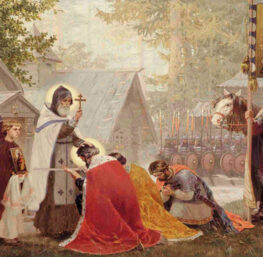 by Andrew Klavan – Judging from his website, I would guess that Jared Lee Loughner suffers from schizophrenia. The man who opened fire with a nine-millimeter Glock in Tucson, Arizona, on Saturday was obsessed with mind control and bizarre, incomprehensible theories of currency and government. He read books by Hitler, Marx, Plato, and Orwell, among others. He did not believe in God. By all appearances, his mind was ruined by madness and his soul by evil. In any case, he murdered a nine-year-old child, a federal judge, and four others while wounding at least twelve, including Congresswoman Gabrielle Giffords, a Blue Dog Democrat well liked on both sides of the aisle.
by Andrew Klavan – Judging from his website, I would guess that Jared Lee Loughner suffers from schizophrenia. The man who opened fire with a nine-millimeter Glock in Tucson, Arizona, on Saturday was obsessed with mind control and bizarre, incomprehensible theories of currency and government. He read books by Hitler, Marx, Plato, and Orwell, among others. He did not believe in God. By all appearances, his mind was ruined by madness and his soul by evil. In any case, he murdered a nine-year-old child, a federal judge, and four others while wounding at least twelve, including Congresswoman Gabrielle Giffords, a Blue Dog Democrat well liked on both sides of the aisle.
I wasn’t going to write anything about the incident because—unlike, say, the frequent and ongoing atrocities inspired by the very intent of Islamism or Communism—it didn’t seem to be a murder caused by any sort of coherent idea. Bad ideas have to be answered by the best ones we’ve got, or they continue to claim the minds of believers and the lives of the just. Madness and evil, on the other hand, are simply things that happen in this broken world. The only proper response is the one in King Lear: “Howl, howl, howl, howl!”
But while little useful can be said about the murders themselves, the rush to narrative of our dishonest and increasingly desperate leftist media does have to be addressed. The Left—which has been unable to discover any common feature uniting acts of Islamist violence worldwide—nonetheless instantly noticed a bridge between the Tucson shooting and its own political opponents. The Chicago Sun-Times ran a slavering editorial blaming “the right.” MSNBC’s Keith Olbermann and the Washington Post’s Eugene Robinson suggested that the killings were inspired by right-wing rhetoric. Politico’s Roger Simon did the same.
But the New York Times was perhaps the worst offender. On its front page, and in its patented smarmily suggestive style, it also implied that Loughner was somehow set off by conservative rhetoric and the Tea Party. “The original health care legislation stirred strong feelings that flared at angry town hall meetings held by many Democratic lawmakers during the summer of 2009,” said the Times, stroking its figurative chin over possible motives for the atrocity. “And there has been broader anger and suspicion rising about the government, its finances and its goals, with the discourse partially fueled by talk shows and Web sites. Tea Party activists also condemned the shooting.”
The Times’s Paul Krugman—who once encouraged readers to hang pro-war Democratic senator Joseph Lieberman in effigy—chimed in on his blog, deploring right-wing political rhetoric and linking a Sarah Palin–backed political ad to the murders. The Palin ad depicted rifle crosshairs on several lawmakers’ names, including Gifford’s, indicating that they were targeted to be voted out of office. (Prominent left-winger Markos Moulitsas of the Daily Kos website did much the same thing, putting a bull’s-eye on Gifford because her views were too moderate for him.)
To be sure, there is a lot of heated rhetoric in American politics, as ever. For instance, last spring, three Democratic congressmen cruelly slandered Tea Party members by accusing them of spitting on them and calling them racial slurs—a charge that was reported as true by the Times even after it was thoroughly debunked by videotapes of the event. Film director Rob Reiner compared the Tea Party to the Nazis on Bill Maher’s HBO show last October. And in May, New York mayor Michael Bloomberg infamously blamed an Islamist attempt to bomb Times Square on “someone who didn’t like health care or something.” Indeed, the Left’s hysterical response to all who disagree with it—that they are racist or sexist or “phobic” or somehow reminiscent of Hitler—has become so predictable that satirists, from the libertarian Greg Gutfeld to the liberal Jon Stewart, have made fun of it in routines.
But never mind that, because the Left’s sudden talk about incendiary political rhetoric in the wake of the Arizona shooting isn’t really about political rhetoric at all. It’s about the real-world failure of leftist policies everywhere—the bankrupting of nations and states by greedy unions and unfundable social programs, the destruction of inner cities by identity politics, and the appeasement of Muslim extremists in the face of worldwide jihad, not to mention the frequently fatal effects of delirious environmentalism. Europe is in debt and on fire. American citizens are in political revolt. Even the most left-wing president ever is making desperate overtures to his right.
But all that might be tolerable to leftists if they weren’t starting to lose control of the one weapon in which they have the most faith: the narrative. The narrative is what leftists believe in instead of the truth. If they can blame George W. Bush for the economic crisis, if they can make Sarah Palin out to be an idiot, if they can call the Tea Party racist until you think it must be true, they might yet retain power in spite of the international disgrace of their ideas. And though they still mostly dominate the narrative on the three broadcast networks, most cable stations, most newspapers, and much of Hollywood, nonetheless Fox News, talk radio, the Internet, and the Wall Street Journal have begun to respond in ways they can’t ignore.
That’s the hateful rhetoric they’re talking about: conservatives interrupting the stream of leftist invective in order to dismantle their arguments with the facts. As for leftists’ reaction to the Arizona shooting, call it Narrative Hysteria: a frantic attempt to capitalize on calamity by casting their opponents, not merely as racist or sexist or Islamophobic this time, but as somehow responsible for an act of madness and evil. Shame on them.
HT: City Journal



